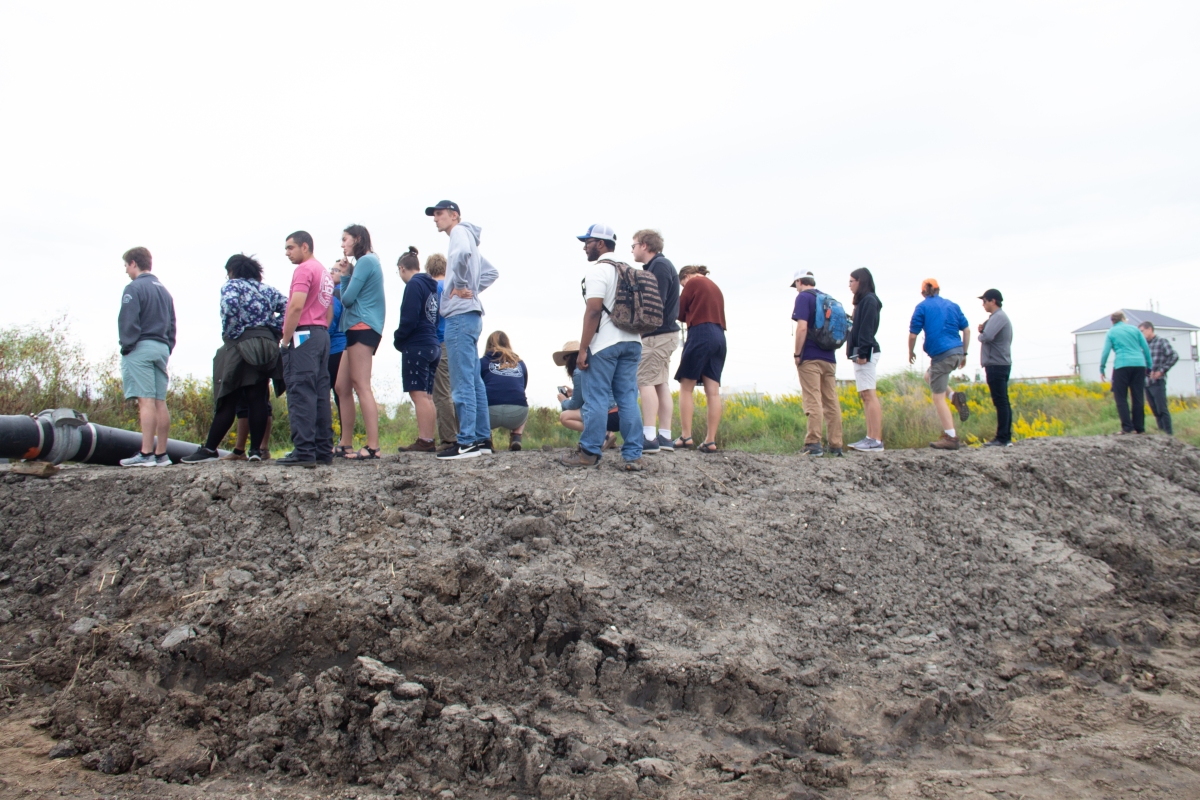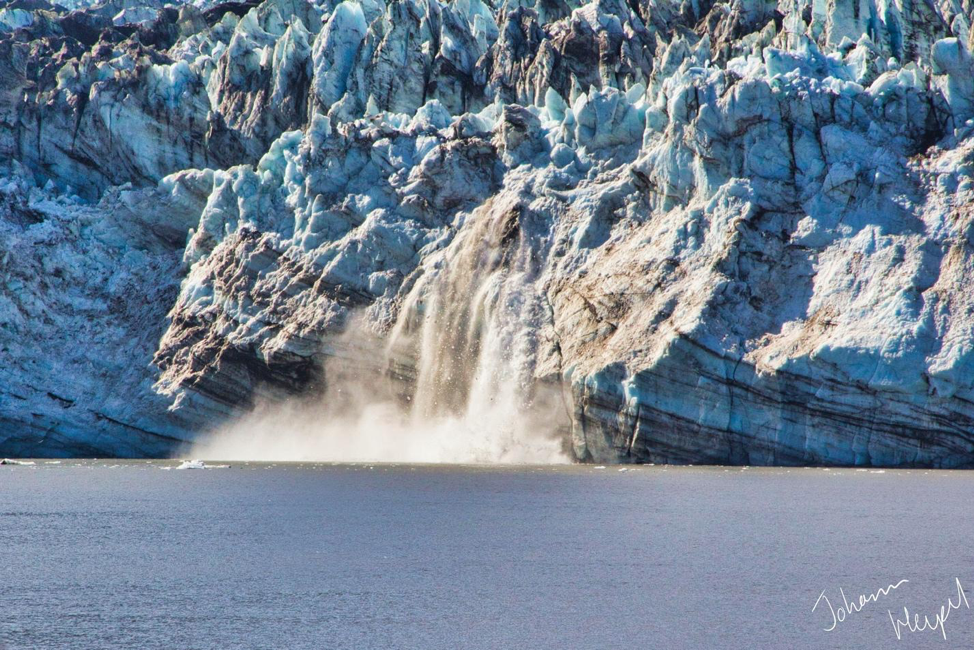by Deion Hammond (F’22)
After a jam-packed week of introductions to my classes for my fall semester at Williams-Mystic, the time to set off to Alaska had quickly come upon me and my equally bewildered compatriots. We assembled in the Seaport parking lot at the crack of dawn, with all our worldly possessions contained in our own individual Williams-Mystic™ duffel bags, and set off that Sunday morning for The Last Frontier. In an almost 4,000 mile journey that would’ve taken a 19th century expedition months to complete, we flew from Boston to Seattle and finally to Juneau, Alaska in the space of only one day! (though we were all too tired from flying all day to appreciate the marvels of modernity in the moment)
Rising through sheer willpower alone at 4am the next day, we reached our first destination in the form of Glacier Bay Lodge. Besides being one of the coziest hotels I’ve ever stayed at, it also provided the perfect jumping off point for exploring the breathtaking wonders that surrounded us on all sides. While most of these wonders were crafted by glaciers in prehistory, the first wonder we visited was a rather recent, manmade one: the Huna Tribal House. There we talked with Darlene See of the Huna Tlingit. She talked to us about the history of her people, their displacement from their home by both a glacier and a callous American government, and their enduring hope that they would someday return to their ancestral home. The soaring wooden beams that surround us there in Glacier Bay, carved with the clan stories of the Huna Tlingit, and the massive formline murals that covered the interior and exterior of the Tribal House spoke to the jubilation of a hope answered.
The wonders we saw on Tuesday were entirely of Mother Nature’s design. From our Glacier Tour Boat, courtesy of the National Park Service, we spent the entirety of the day with our eyes glued to the horizon. There we saw flocks of cormorants, kittiwakes, and even puffins. A raft of sea lions, emanating a stench of sour fish that reached us hundreds of feet away, sunbathed on a small marble island. A lucky few even caught the flute of a killer whale! But more spectacular than any of these were the blue ice glaciers at the end of our long voyage. The last remnants of the great bulldozers that had carved out the North American continent thousands of years ago, the glaciers now stood as noble sentinels to herald the end of our voyage.
On Wednesday we would face our greatest challenge of the entire expedition: fog. The 10-person seaplanes to Sitka we had planned on taking that morning could not fly through the dense haze that had rolled in that morning, and so we returned to Glacier Bay for one more day. Making the most of our newfound time, we explored the intertidal zone to find a plethora of star fish and sea anemone and examined the 50-foot skeleton of the humpback whale Snow. By the afternoon the fog had dissipated, and so as the stars began to twinkle into view, our new flight to Sitka set off without delay.
Beginning our morning with a walk through the cedars and alders of the Tongass rainforest, Thursday would be a day of highs and lows for me. The highlights were plentiful. From meeting with Janet Clark and Sarah Tobey of the Sitka Sound Science Center to learn about the aforementioned cedars and alders to hearing the stories of Dr. Sonia Ibarra and her mission to educate academia on the importance of indigenous knowledge, one mind at a time, I realized just how little of the world I actually knew. And when we explored the intertidal around Magic Island before we donned our wetsuits and went snorkeling along the shore, I realized just how little of the world I had actually seen. But after these best of times, there was the worst of times when my hand was selected as the quarry of an ornery bee’s stinger, leading to my early retirement for the day.
Fully-rested on Friday after 12 hours of uninterrupted Benadryl-powered slumber, my art-loving itch would be scratched once more at Sitka National Historic Park with a first-hand look at how totems are crafted in the traditional formline style by the exceedingly down-to-earth carver Will Peterson. We remained in the park for our meeting with Louise Brady, who taught us about the Tlingit war with the Russians and the continuing Tlingit war to secure their food sovereignty. After her presentation, we met my favorite speaker of the trip: Chuck Miller. Chuck, as a dedicated student and now teacher on Tlingit lifeways, spoke with the gravity of one that has been entrusted with a history that threatens to fade with each passing day, but also the humor of one who has had to endure many an obvious question of oblivious tourists. His words painted a picture of heartbreak, but also of hope for the next generation of elders. Even if I should forget the soaring glaciers, I’m sure I will still remember his stories. We finished our day touring the local fishing co-op and hearing about how Alaskan fishermen are finally beginning to work together from one Stephen Rhoads (though he might have been better styled as Captain Ahab with his outspoken hatred for sperm whales and their tendency to steal the entirety of his catch) and afterwards learning about the fight for equitable fisheries from Williams-Mystic alumna Linda Behnken aboard her fishing boat. Her dog, also aboard the boat, did not speak, but his presence was greatly appreciated nonetheless.
Saturday was our last full day in Sitka, and so after a lovely talk with locals Sarah and Eric Jordan on the basics of commercial fishing in Alaska, we were let loose to explore the town and purchase all manner of souvenirs to bring home with us. In the afternoon we visited the Sitka Raptor Center, and much to my disappointment, there were no dinosaurs to be found roaming around Jurassic Park style. However there were many eagles and owls, perched almost close enough to touch, that alleviated my disappointment. The last site we visited was a nearby landslide that had galvanized Sitka into forming a community-driven landslide watch group. Although not especially noteworthy compared to all the other sights we had seen, (sorry geologists!) I thought it was an appropriate ending. Like that landslide, one impulse had sent me cascading down a path I had never known I’d ever wanted to take, except instead of the end result being diorite and destruction, it was insight from instruction.
My greatest takeaway from my time in Alaska (besides a camera roll now replete with pictures of glaciers) is my excitement for further field seminars with this cohort. In such a small group, I have found a collection of some of the smartest, kindest, and funniest folks I have yet met. Whether furthering the culinary field by combining my cheesecake with an Italian Wedding soup, which Evan coined the Italian Divorce, or giving myself RSI (repetitive strain injury) playing ERS (Egyptian Ratscrew,) some of my most cherished memories are ones that can never be adequately described, only remembered. Dumb inside jokes like this are – in my humble and objective opinion – what relationships are built upon, and we have no shortage of inside joke bedrock from Alaska.
While we were in Alaska we had a continual Leave No Trace policy, but try as we might, I’m afraid we broke it along the way. I had left with classmates and returned without them. I did, however, bring back newfound friends.






















